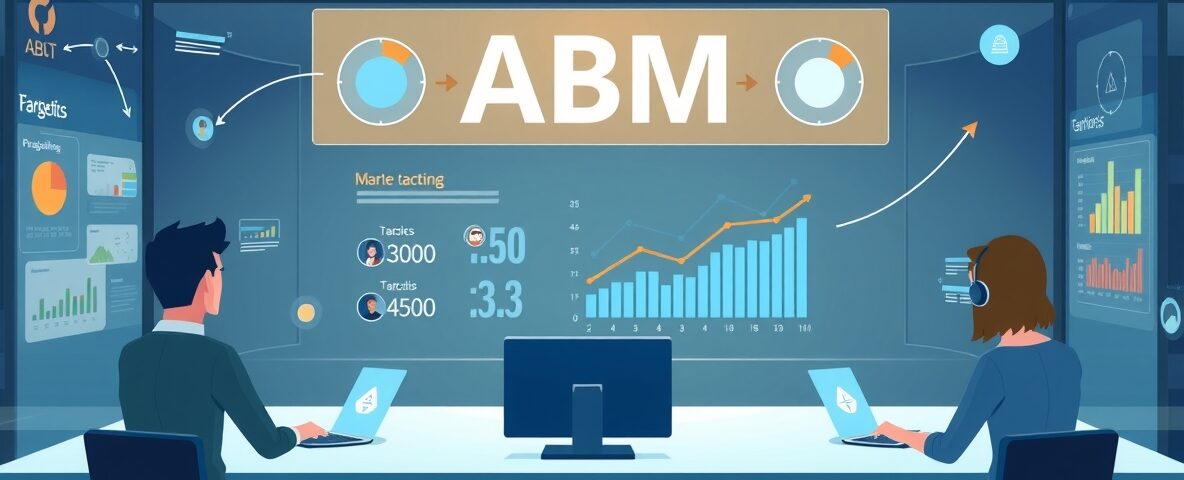Key Influencer Marketing Strategies to Boost B2B Leads in Singapore
September 19, 2025
How Top Marketers Win with Account-Based Marketing Playbooks
September 19, 2025Understanding the ABM Landscape
Account-Based Marketing (ABM) has evolved into a cornerstone strategy for B2B success, shaping the way businesses engage with their most valuable clients. In the ever-changing landscape of marketing, ABM stands as a personalized and strategic approach, targeting high-value accounts with precision. It’s not just a tactic; it’s a mindset shift, emphasizing quality over quantity in lead generation. As we delve into the strategies for B2B success in 2024, understanding the roots and evolution of ABM becomes paramount.
ABM, once considered a niche strategy, has become mainstream due to its effectiveness in creating meaningful connections with key accounts. Previously, B2B marketing focused on casting a wide net, hoping to capture as many leads as possible. However, ABM reverses this approach, concentrating efforts on a select group of high-potential accounts. This section explores the historical trajectory of ABM, tracing its roots, and highlights its transformation into a linchpin of modern B2B marketing.
The Dynamics of B2B Marketing in 2024
The year 2024 brings with it a dynamic landscape in B2B marketing, shaped by digital transformation, evolving customer expectations, and a highly competitive environment. Businesses no longer operate in silos; instead, they navigate a digital ecosystem where connectivity and personalization reign supreme. Understanding these dynamics is essential for crafting ABM strategies that resonate with the current market scenario.
Digital transformation has altered how businesses operate, influencing every facet of marketing and sales. The rise of e-commerce, data analytics, and AI has ushered in a new era of possibilities. Customers, too, expect a seamless and personalized experience at every touchpoint. This shift in expectations challenges B2B marketers to not only meet but exceed customer demands. Moreover, the competitive landscape is fiercer than ever, with companies vying for the attention of a limited pool of high-value clients.
In 2024, successful B2B marketing hinges on adapting to these dynamics. ABM, with its focus on personalization and targeted engagement, emerges as a strategic response to these challenges. This section explores how businesses can align their strategies with the prevailing dynamics to ensure relevance and success.
Crafting a Robust ABM Framework
Identifying Target Accounts
The cornerstone of any successful ABM strategy lies in the meticulous identification of target accounts. In the vast sea of potential clients, pinpointing those with the highest potential for conversion requires a strategic and data-driven approach. Leveraging data analytics becomes imperative in this process, providing insights into customer behavior, preferences, and potential value to the business.
Defining Ideal Customer Profiles (ICPs) is a crucial step in narrowing down the scope. What characteristics make an account an ideal fit for your products or services? What industries, company sizes, or geographical locations align with your business objectives? These questions guide the creation of ICPs, helping streamline the identification process.
Additionally, incorporating predictive analysis adds a forward-looking dimension to account identification. Predictive analytics utilizes historical data and machine learning algorithms to forecast future trends. By understanding which accounts are likely to yield the highest returns, businesses can prioritize their efforts effectively.
In the world of B2B, where personalization is paramount, the identification of target accounts sets the stage for tailored interactions and focused marketing efforts.
2.2 Personalization at Scale
Gone are the days of generic marketing messages that appeal to the masses. In 2024, personalization takes center stage, and ABM is at the forefront of this shift. Personalization at scale is not a mere buzzword; it’s a necessity in a market where customers expect brands to understand their unique needs and challenges.
Dynamic content strategies play a pivotal role in achieving personalization at scale. This involves creating content that adapts based on the specific attributes and behavior of the target accounts. Whether through dynamic website content, personalized emails, or targeted social media campaigns, the goal is to make every interaction feel tailor-made for the recipient.
AI-driven personalization tools further enhance the scalability of these efforts. Machine learning algorithms analyze vast amounts of data, enabling businesses to predict customer preferences and deliver content that resonates. Case studies showcasing the success stories of companies implementing robust personalization strategies serve as valuable benchmarks for others aiming to achieve similar results.
In the realm of B2B marketing, where relationships are built on trust and understanding, personalization at scale through ABM is a game-changer.
Multi-Channel Engagement
The digital age has ushered in a multitude of channels for communication, and successful B2B marketing in 2024 requires a strategic integration of these channels into the ABM framework. Multi-channel engagement goes beyond traditional methods, encompassing a holistic approach that includes social media, email marketing, and even interactive platforms like webinars.
Integrating social media into ABM strategies allows businesses to connect with their target accounts on platforms where they actively engage. Whether through thought leadership content, targeted ads, or direct engagement, social media becomes a powerful tool in the ABM arsenal.
Email marketing, a tried-and-true method, evolves with innovations in automation and personalization. Crafting compelling email campaigns that resonate with the unique needs of target accounts ensures a direct and impactful communication channel.
Webinar campaigns, often overlooked in traditional B2B strategies, gain prominence in 2024. The interactive nature of webinars allows businesses to showcase expertise, engage with target accounts in real-time, and provide valuable insights.
The key is not just utilizing these channels individually but orchestrating a seamless and cohesive experience across them. Successful multi-channel engagement in ABM requires a nuanced understanding of how each channel contributes to the overall narrative and impact on target accounts.
2.4 Sales and Marketing Alignment
One of the perennial challenges in B2B organizations is the misalignment between sales and marketing teams. ABM seeks to bridge this gap by fostering collaboration and shared goals between these two integral functions. Breaking down silos is not just a recommendation; it’s a necessity for the success of ABM strategies.
Collaborative technologies play a crucial role in aligning sales and marketing efforts. Shared platforms, such as integrated CRMs and communication tools, provide a unified space for both teams to collaborate on account-specific strategies. This not only streamlines communication but also ensures that both teams are working with the same set of data and insights.
Measuring success together is a fundamental aspect of alignment. ABM requires a shared set of key performance indicators (KPIs) that align with overarching business objectives. This collaborative approach shifts the focus from individual achievements to collective success, reinforcing the symbiotic relationship between sales and marketing.
In the world of B2B, where the buyer’s journey is intricate and involves multiple touchpoints, the alignment of sales and marketing ensures a seamless and unified approach, maximizing the impact of ABM strategies.
Technological Integration for ABM Excellence
AI and Machine Learning in ABM
The infusion of Artificial Intelligence (AI) and machine learning into ABM heralds a new era of precision and efficiency. Predictive analytics, a subset of AI, takes center stage in identifying high-potential accounts by analyzing vast datasets and discerning patterns.
In the realm of lead scoring, AI algorithms go beyond traditional methods, considering not just explicit data but also implicit signals. This nuanced approach ensures that accounts are not just assessed based on historical patterns but are also evaluated in real-time, adapting to evolving customer behaviors.
Chatbots, another AI-driven tool, revolutionize customer interaction in ABM. These virtual assistants provide instant responses, gather relevant information, and even assist in the initial stages of the buyer’s journey. The efficiency and immediacy they bring to the engagement process align with the personalized nature of ABM.
Real-time decision-making becomes a hallmark of AI integration. From dynamically adjusting content based on user behavior to automating certain aspects of the engagement process, AI ensures that ABM strategies are not just data-driven but also nimble and adaptive.
CRM Enhancements
Customer Relationship Management (CRM) systems serve as the backbone of ABM strategies. However, in 2024, customization is the key. Tailoring CRM systems to align with the unique requirements of ABM ensures that the technology complements the strategy rather than constraining it.
Enhancing customer journeys within the CRM system becomes a priority. Mapping out the intricate paths that key accounts take allows for a deeper understanding of their needs and preferences. This, in turn, informs the personalized approach that defines ABM.
CRM integration challenges are not uncommon, and this section addresses the potential roadblocks and provides practical solutions. Whether it’s ensuring data accuracy or streamlining communication between departments, the goal is to make the CRM system an enabler rather than a hindrance.
In the dynamic world of B2B, where every interaction contributes to the overall relationship, CRM enhancements tailored to ABM strategies become indispensable for success.
Automation and ABM Synergy
Automation and ABM are not mutually exclusive; in fact, they are powerful allies. Workflow automation streamlines repetitive tasks, allowing marketing and sales teams to focus on strategic activities. From lead nurturing to content distribution, automation ensures efficiency without sacrificing the personalized touch that defines ABM.
Email campaign automation takes center stage, ensuring that the right messages reach the right accounts at the optimal times. Drip campaigns, triggered by specific actions or milestones, guide target accounts through the buyer’s journey with precision.
However, the road to successful automation in ABM is not without its challenges. Overcoming common pitfalls, such as excessive reliance on automation or neglecting the human element, is crucial. Striking the right balance ensures that automation enhances ABM strategies rather than detracts from them.
Data Security and Privacy Compliance
In an era where data is the lifeblood of B2B marketing, ensuring its security and compliance with privacy regulations is non-negotiable. General Data Protection Regulation (GDPR) looms large, and businesses must navigate its implications to build trust with their target accounts.
GDPR and its implications on ABM practices are explored in detail. From obtaining explicit consent to the rights of data subjects, understanding the intricacies of GDPR ensures that ABM strategies are not just effective but also ethically sound.
Best practices in data security go beyond regulatory compliance. This section delves into encryption methods, secure storage protocols, and proactive measures to safeguard sensitive information. Building trust through compliance becomes a competitive advantage in the B2B landscape.
Measuring and Adapting ABM Success
Key Performance Indicators (KPIs) in ABM
Measuring the success of ABM strategies goes beyond traditional metrics. While lead generation and conversion rates remain pertinent, the nuances of ABM require a more comprehensive set of Key Performance Indicators (KPIs).
Beyond traditional metrics, such as the number of leads generated or conversion rates, ABM introduces KPIs that align with the personalized and targeted nature of the strategy. Metrics like account engagement scores, which quantify the depth and breadth of interactions, provide a more nuanced understanding of success.
ROI measurement strategies in ABM involve assessing the impact on overall business objectives. Whether it’s revenue generated from target accounts or the long-term value of those accounts, measuring ROI requires a holistic approach that goes beyond immediate gains.
Benchmarking becomes an integral part of continuous improvement in ABM. Analyzing performance against industry standards and competitor benchmarks provides valuable insights. This section explores how businesses can establish benchmarks and leverage them for ongoing refinement.
A/B Testing in ABM Campaigns
A/B testing, a staple in marketing, takes on a new dimension in the context of ABM. Designing effective experiments that go beyond surface-level changes requires a strategic approach.
The section delves into the intricacies of A/B testing in ABM campaigns, exploring how to identify variables that truly impact outcomes. Whether it’s testing different messaging tones or varying the timing of interactions, the goal is to extract actionable insights that inform future strategies.
Interpreting results accurately is paramount. This involves not just looking at surface-level metrics but understanding the underlying dynamics at play. What may seem like a small change in conversion rates could have profound implications for long-term engagement.
Iterative testing for optimization is the key takeaway. ABM strategies are not set in stone; they evolve based on continuous testing and refinement. This section guides businesses on how to embrace a culture of experimentation within the ABM framework.
Feedback Loops for Continuous Refinement
The success of ABM is not a one-time achievement but a continuous journey of refinement. Feedback loops, both from customers and internal stakeholders, play a pivotal role in this iterative process.
Customer feedback integration involves actively seeking insights from target accounts. What worked well? What could be improved? Direct feedback from those on the receiving end of ABM strategies provides invaluable insights for enhancement.
Internal stakeholder feedback ensures that the alignment between sales and marketing is maintained. What insights are sales teams gaining from direct interactions with target accounts? How can marketing better support the sales process? These questions guide the internal feedback loop.
Agile approaches in ABM extend beyond strategy to the mindset of the teams involved. This section explores how adopting agile methodologies, with a focus on adaptability and responsiveness, contributes to the continuous refinement of ABM strategies.
Adapting to Market Changes
The B2B landscape is inherently dynamic, subject to economic shifts, technological advancements, and evolving customer preferences. ABM strategies must not only adapt to these changes but anticipate them to stay ahead of the curve.
Navigating economic shifts involves a nuanced understanding of market dynamics. This section explores how businesses can adjust their ABM strategies in response to economic downturns or upswings, ensuring resilience in the face of uncertainty.
Competitor analysis strategies in ABM go beyond traditional assessments. It involves understanding not just what competitors are doing but why they are doing it. By deciphering the motivations behind competitor actions, businesses can glean insights for their own strategies.
Case studies showcasing ABM success amidst market changes serve as practical examples. Whether it’s a recession-proof ABM strategy or one that capitalizes on emerging trends, these case studies provide valuable lessons for businesses navigating dynamic markets.

Overcoming Common ABM Challenges
Budget Constraints and Solutions
While ABM is a potent strategy, its implementation can pose challenges, particularly in the context of budget constraints. This section explores practical solutions for maximizing ROI with limited resources.
Maximizing ROI with limited resources involves prioritizing high-impact strategies. This requires a strategic assessment of where resources can yield the greatest return while still aligning with ABM objectives. It involves understanding which channels, campaigns, or accounts have the highest potential for conversion and focusing efforts where they matter most.
Cost-effective technology adoption is another avenue for overcoming budget constraints. This involves carefully selecting tools and platforms that offer maximum value for the investment. From affordable CRM solutions to open-source marketing automation tools, businesses can leverage technology without breaking the bank.
Prioritizing high-impact strategies requires a keen understanding of the target audience and their preferences. This section provides actionable insights into identifying the most effective channels and tactics, ensuring that every dollar spent contributes to the overarching goals of ABM.
Alignment with Sales Teams
One of the perennial challenges in B2B organizations is the misalignment between sales and marketing teams. ABM seeks to bridge this gap by fostering collaboration and shared goals between these two integral functions. Breaking down silos is not just a recommendation; it’s a necessity for the success of ABM strategies.
Building strong collaborative relationships between sales and marketing involves more than just shared goals—it requires a cultural shift. This section explores how businesses can create an environment where both teams see themselves as partners in the larger mission of driving revenue and building lasting customer relationships.
Shared goals and metrics become the cornerstone of alignment. In the world of ABM, success is not just about lead quantity but about the quality of engagement and conversion. Defining metrics that both sales and marketing teams can rally around ensures a unified approach to achieving ABM objectives.
Resolving common misalignments requires open communication and a commitment to understanding each other’s challenges. Whether it’s a mismatch in expectations or a lack of clarity on roles, addressing these issues head-on is crucial for successful ABM implementation.
Content Relevance Across Accounts
The personalized nature of ABM demands a nuanced approach to content creation. Generic content that may suffice in traditional marketing falls short in the realm of ABM, where each interaction is tailored to the unique needs of target accounts.
Dynamic content creation becomes a key strategy for ensuring content relevance across accounts. This involves creating content that adapts based on the specific attributes and behavior of the target accounts. From personalized landing pages to account-specific whitepapers, the goal is to make every piece of content resonate with the recipient.
Aligning content with buyer journeys adds another layer of complexity. This section explores how businesses can map out the buyer’s journey for key accounts, ensuring that content is not only relevant but also strategically placed at each stage of the journey.
The ongoing debate between personalization and generic content is addressed, emphasizing the need for a balanced approach. While personalization is crucial for engagement, there are instances where more broadly relevant content can still add value. Striking this balance ensures that content remains a powerful tool in the ABM arsenal.
Scalability Issues in ABM
As businesses witness the success of their ABM strategies, the question of scalability inevitably arises. Implementing scalable solutions becomes crucial to ensuring that the benefits of ABM can be extended to a broader set of target accounts.
Implementing scalable solutions involves a strategic assessment of current processes and technologies. This section explores how businesses can identify bottlenecks and leverage technologies that can grow with the evolving needs of ABM.
Case studies highlighting successful examples of scaling ABM provide practical insights. Whether it’s expanding to new markets or accommodating a growing list of target accounts, these case studies showcase strategies that businesses can emulate for their own scalability.
Avoiding pitfalls in scaling strategies is equally important. This section addresses common challenges, such as a decline in personalized engagement or a loss of focus on high-value accounts, and provides actionable solutions to navigate these challenges successfully.
Future Trends in ABM
AI Advancements in ABM
The future of ABM is intricately tied to the advancements in Artificial Intelligence (AI). This section explores how AI is set to revolutionize ABM, providing marketers with unprecedented capabilities for precision and efficiency.
The role of AI in predictive analysis takes center stage. The ability to analyze vast datasets in real-time, predict future trends, and adjust strategies accordingly positions AI as a fundamental tool in the ABM toolkit. This section delves into practical applications and case studies showcasing the impact of AI-driven predictive analysis.
Emerging AI technologies offer a glimpse into the future possibilities of ABM. From enhanced personalization algorithms to AI-powered chatbots with more advanced conversational capabilities, businesses can prepare for the next wave of AI advancements in ABM.
Future AI-driven ABM possibilities provide a visionary look into what the landscape may look like in the coming years. This section explores speculative yet plausible scenarios, such as fully autonomous ABM systems and AI-generated content strategies, inviting businesses to stay ahead of the curve.
Enhanced Integration with AR and VR
As technological boundaries continue to expand, the integration of Augmented Reality (AR) and Virtual Reality (VR) into ABM becomes a foreseeable trend. This section explores how these immersive technologies can elevate B2B engagements to new heights.
Virtual engagements in B2B take on a new dimension with AR and VR. From virtual product demonstrations to immersive tours of facilities, businesses can create impactful and memorable experiences for their target accounts. Practical examples and case studies demonstrate the potential of enhanced integration.
Augmented Reality for product demonstrations becomes a game-changer. This section delves into how businesses can leverage AR to showcase products in a virtual space, allowing target accounts to interact with offerings in a more tangible way.
The rise of virtual trade shows is explored as a trend that holds immense potential for B2B marketing. From cost-effective exhibition opportunities to global reach, businesses can reimagine their approach to industry events through virtual experiences.
Sustainable and Ethical ABM Practices
As societal and environmental concerns take center stage, the future of ABM includes a focus on sustainable and ethical practices. This section explores how businesses can align their ABM strategies with principles of responsibility and sustainability.
Ethical data usage becomes a cornerstone of future ABM practices. This involves transparent communication with target accounts regarding data collection and usage. The section explores how businesses can build trust by prioritizing ethical data practices.
Sustainable marketing strategies in ABM go beyond immediate gains to consider long-term impacts. This section explores how businesses can align their ABM campaigns with broader sustainability goals, from reducing environmental impact to supporting social causes.
Building a responsible brand image becomes a competitive advantage in the B2B landscape. This section provides insights into how businesses can weave sustainability and ethical practices into their brand narrative, enhancing not just customer relationships but also overall brand reputation.
Globalization and ABM
The globalization of ABM strategies emerges as a future trend, with businesses expanding their reach to international markets. This section explores how cultural sensitivity, tailored approaches, and case studies of successful global ABM campaigns play pivotal roles in this evolving landscape.
Cultural sensitivity in B2B marketing becomes paramount when extending ABM strategies globally. This section delves into how businesses can navigate diverse cultural landscapes, avoiding pitfalls and ensuring that their strategies resonate with target accounts from different backgrounds.
Tailoring ABM for international markets involves more than just translating content. This section explores practical strategies for adapting ABM approaches to varying market dynamics, regulatory environments, and cultural nuances.
Case studies highlighting successful global ABM campaigns provide inspiration for businesses looking to expand their reach. Whether it’s entering new regions or catering to diverse industries, these case studies offer actionable insights for achieving success on a global scale.
Conclusion
Recap of Key ABM Strategies
As we reach the conclusion of this comprehensive guide, it’s essential to recap the key ABM strategies that can propel businesses to success in the dynamic landscape of 2024. From identifying target accounts to leveraging advanced technologies like AI and AR, businesses have a diverse toolkit at their disposal.
Summarizing crucial takeaways, businesses are reminded of the importance of personalization, collaboration between sales and marketing, and the strategic use of data in crafting effective ABM strategies. These key strategies form the foundation for success in the ever-evolving B2B landscape.
Empowering B2B Success in 2024
Empowering B2B success in 2024 involves more than just implementing ABM strategies; it requires a mindset of adaptability and continuous improvement. By embracing actionable insights, staying agile in dynamic markets, and looking ahead to future ABM innovations, businesses can position themselves as leaders in their industries.
As we conclude this guide, the journey towards B2B success continues. The strategies outlined herein serve as a compass, guiding businesses through the intricacies of ABM and setting them on a trajectory of sustained growth and customer satisfaction.






